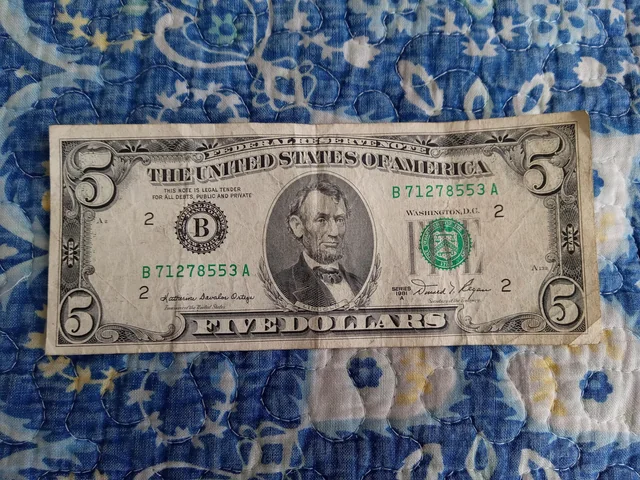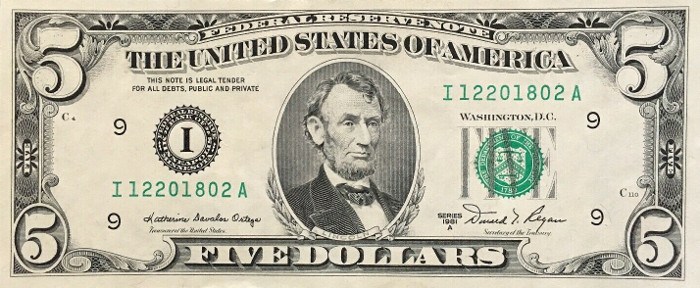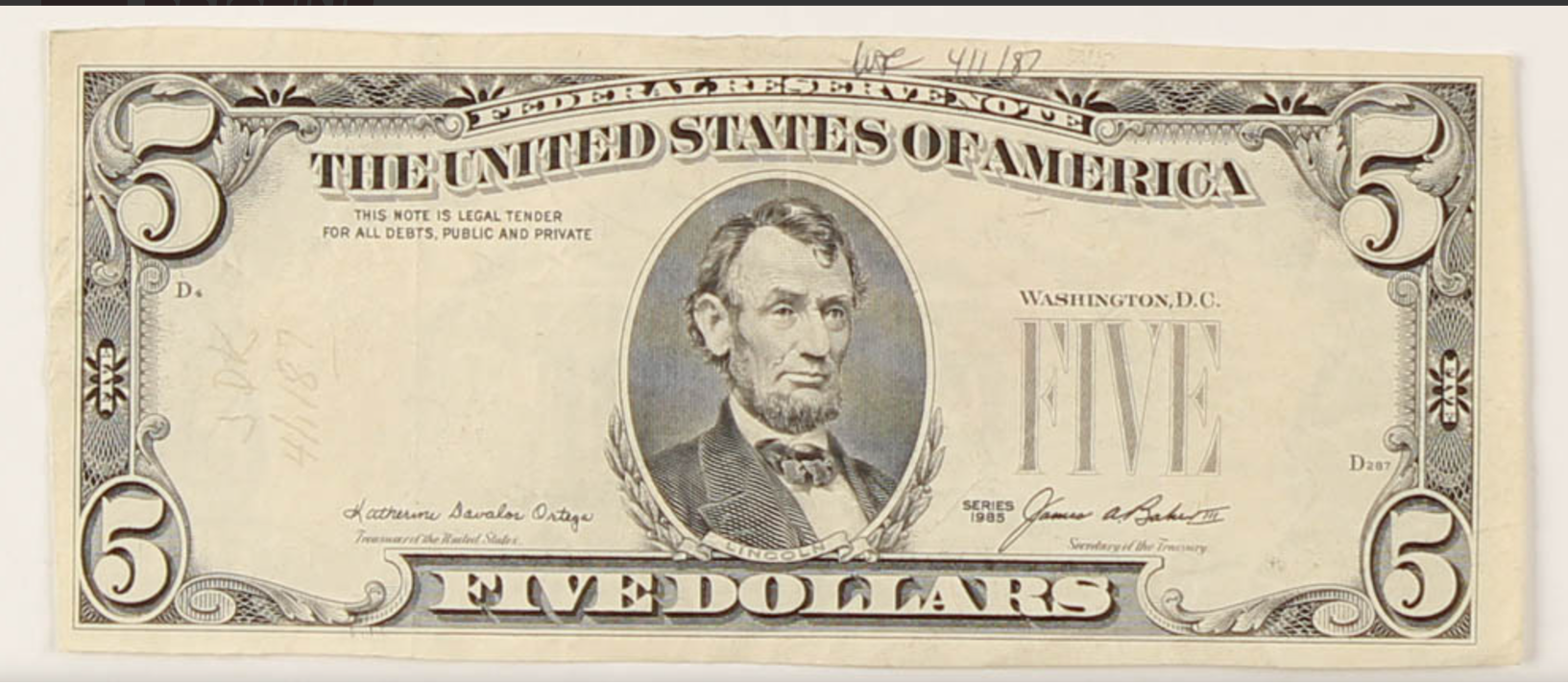When it comes to currency collecting, the value of a particular note depends on several factors, including its condition, rarity, and any special features it may have. If you’re asking the question, “1981 5 dollar bill value?” you’re likely interested in how much your old $5 bill might be worth today. In this article, we will explore the value of the 1981 $5 bill, its various series, and factors that can influence its worth, such as star notes, errors, and its grading system.
Keep reading to find out everything you need to know about the 1981 five dollar bill and whether your note is worth more than its face value.
Understanding The 1981 5 Dollar Bill
The 1981 $5 bill belongs to the Federal Reserve Note category and was issued by the U.S. government as part of the currency series released in 1981. Like other bills in the U.S. monetary system, it was printed in various series, including 1981 and 1981A.

These bills are part of the paper currency that features the iconic portrait of Abraham Lincoln on the front and the Lincoln Memorial on the back.
The 1981 $5 bill is not particularly rare compared to other older bills, but it does have some notable features that can make it more valuable under the right circumstances.
The key factors influencing the value of this bill are its condition, whether it’s part of a special series, and whether it has any unique characteristics like star notes or printing errors.
Specifications of the 1981 $5 Bill:
- Denomination: $5.00 USD
- Type: Federal Reserve Note
- Series: 1981 and 1981A
- Design: Abraham Lincoln on the front and the Lincoln Memorial on the back.
Now, let’s explore what makes the 1981 $5 bill valuable and how the different series and variations can impact its worth.
How Much Is A 1981 $5 Dollar Bill Worth Today?
When people ask the question “1981 5 dollar bill value?” they’re typically hoping to learn about the worth of their notes in today’s market. The answer depends on several factors, with condition being one of the most important considerations.
While most 1981 $5 bills in circulated condition are worth close to their face value of $5, certain versions of these bills can command a premium depending on their grade and rarity.
In terms of purchasing power, $5 in 1981 was equivalent to approximately $17.36 today, accounting for an inflation rate of 2.87% per year over the past 44 years. This inflation has increased the cumulative price of goods by about 247.20%, so while the face value of the bill has not changed, its purchasing power has diminished over time.
This means that older $5 bills like the 1981 series carry historical value, but that doesn’t necessarily mean they are worth much more unless they have special characteristics.
For the most part, 1981 $5 bills in circulated condition are not worth much more than $5. However, uncirculated bills or those with special features can fetch higher prices. The table below provides an overview of how the 1981 $5 bill value varies based on its condition:
- Very Fine Condition: The 1981 $5 bills in very fine condition are typically worth around $7.50. These bills will have visible signs of circulation, such as minor creases or folds, but are still in relatively good shape.
- Uncirculated (MS 63) Condition: Uncirculated bills, which have never been used in circulation and retain their crispness, can be worth significantly more. A 1981 $5 bill in uncirculated condition with a grade of MS 63 can sell for anywhere between $25, depending on the note’s rarity and demand.
The Impact of the 1981A Series
Another important consideration when determining the value of your 1981 $5 bill is whether it belongs to the 1981A series. The 1981A series features notes printed in the same year but with slightly different production details, which can affect their value.

These notes are somewhat rarer than the 1981 series bills, and thus, they can command a higher price.
1981A $5 Bill Value: A 1981A $5 bill in very fine condition is typically worth around $15. If the bill is in uncirculated condition, it can fetch anywhere between $35 and $50, depending on its grade.
Because the 1981A series is less common, collectors may be more inclined to pay a premium for these notes, especially if they are in pristine condition.
For many collectors, the appeal of the 1981A series comes from its relatively low supply and the chance to own a piece of U.S. currency history.
Star Notes and Their Value
One of the most interesting variations of the 1981 $5 bill is the star note. Star notes are replacement bills issued by the Federal Reserve when a note is damaged or misprinted during production. The star symbol at the end of the serial number indicates that the bill is a replacement note, making it rarer and often more valuable than standard notes.
If you have a 1981 $5 star note, it could be worth more than the regular bills in circulation. Here’s how star notes from the 1981 series compare in value:
- 1981 $5 Star Notes: Star notes from the 1981 series are typically worth around $20 to $30 in very fine condition. Uncirculated star notes, especially those graded MS 63, can sell for between $60 and $75. Star notes issued by the Federal Reserve Bank of Minneapolis tend to be the most valuable.
- 1981A $5 Star Notes: Star notes from the 1981A series are generally worth more than those from the 1981 series. In very fine condition, these notes can be worth around $45, while uncirculated star notes with an MS 63 grade can fetch about $90.
Star notes are rare by nature, so they hold a certain allure for collectors. If you have a star note, it is always a good idea to have it professionally graded, as this can significantly increase its market value.
Error Notes and Their Rarity
Another important factor in determining the value of your 1981 $5 bill is whether it contains any printing errors. Errors can occur during the production process, and when they do, they can result in a bill with an unusual or unique feature. Errors can include misprints, off-center printing, or other noticeable defects.
These error notes can be incredibly valuable to collectors because they are one-of-a-kind. For example, a misprinted serial number or a bill with ink smudges or unusual patterns can be highly sought after in the currency collecting world.
If you suspect that your 1981 $5 bill has an error, it’s worth having it inspected by a professional currency dealer.
Grading System for Currency Notes
When determining the value of any $5 bill, including the 1981 series, the grading system is crucial. Currency notes are graded on a scale from 1 to 70, with 70 being a perfect note. The higher the grade, the more valuable the note tends to be.
- Very Fine (VF): A bill in this grade has been in circulation but remains in good condition, showing minimal signs of wear such as slight creases or smudges.
- Uncirculated (MS 63): An uncirculated note shows no signs of ever having been in circulation. The note will be crisp, well-centered, and free from any creases or significant marks.
How to Protect Your 1981 $5 Bill
If you own a valuable 1981 $5 bill, it’s important to protect it properly to preserve its condition. Store the bill in a currency holder or a protective sleeve designed specifically for paper money. This will help prevent wear and tear and protect the bill from moisture, dirt, or other damaging factors.
Conclusion: 1981 5 Dollar Bill Value
If you’re wondering “1981 5 dollar bill value?”, most 1981 $5 bills in circulated condition are not worth more than their face value of $5. However, if you have an uncirculated bill or one that is part of the 1981A series, you might be able to sell it for a premium. Additionally, star notes and error notes can significantly increase the value of your bill. Star notes, in particular, are rare and valuable, and they often sell for much higher prices than regular notes.
The value of a 1981 $5 bill depends on factors such as its series, condition, and any special characteristics it may have. Whether you are a collector or simply someone curious about the worth of your $5 bill, understanding these factors will help you determine the true value of your 1981 five dollar bill.

